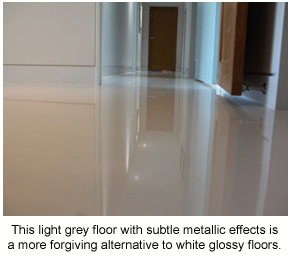Home › Advice › Know How › Knowhow
The Challenge of White Glossy Floors
For as long as I’ve been doing decorative epoxies there’s been strong demand for pure white floors,
particularly from homeowners. But, are they really a good flooring choice?
Now, I can certainly understand why the pristine white floor you see in glossy magazine spreads would capture the imagination of a lot of
people. Those photos can certainly look amazing! However, after many years of doing them and seeing them done, I also realise that similar
results are by no means guaranteed and these types of floors have a considerable downside.
The main problems with glossy white floors
The following are four major issues that make me think twice about proceeding with a glossy plain white floor:
-
Imperfections - Glossy white floors, more than any other, will show up defects in the final film. Of course measures can be taken to
ensure the surface is meticulously prepared, high-quality application tools are used, and the floor is sealed off to prevent bugs and
dust landing on the floor, however in reality perfection is very hard to achieve. All you need is a small dip, a few bubbles, or a stuck
insect and the dream of a glossy white floor can turn into a nightmare because most floor owners will have visions of a white mirror
across the whole floor.
-
Cost - Installing a glossy white floor will generally require more coats or a very thick single coat, which means more product and a higher
cost. There are two main reasons for this: firstly, white needs greater thickness to fully block out the surface underneath, and secondly,
extra build is required to level out any unevenness and deliver a flawlessly flat finish.
You can read a more general discussion on epoxy flooring cost in a separate know how article.
-
Finish - Speaking of flawlessly flat finish, perhaps the biggest hurdle for anyone chasing a glossy white floor is the fact that even with
everything else falling into place during application, not all resins can actually deliver it. Just any old epoxy binder isn’t going to form
a beautifully smooth, glossy finish regardless of how thick it’s applied and specialist decorative epoxies are the only hope.
-
Maintenance - No dirt is white and glossy white floors have a great knack of showing up even the slightest hint of everyday dust. Scuffing
and yellowing also tend to take on an extra dimension when they have a white canvas to work with. All in all, those with a white floor can
find cleaning becomes a full time job.
With all those points in mind, you can start to see why I’m a little cautious when people ask for the perfect white floor.
A more forgiving white floor
So, if white floors aren’t necessarily the way to go, what do I recommend instead? I think the best thing contractors can do in these
situations is to try to offer their client the same type of look/feel, but with a few small changes to make the floor more forgiving and
drag the odds back in their favour.
A good option here is the use of metallic effect pigments in combination with off-white colours - something like a shimmering pearl finish
will add an extra dimension to the floor, help draw attention away from the surface itself, and, at the end of the day, appear very close to
white when side by side with most décor. If the client isn’t sold on that sort of tweaking and insists on plain white as the colour, then
I’ll turn my attention to the gloss levels and see if something less than a mirror is acceptable. The use of sacrificial polishes (or even
clear non-slip topcoats) to create a semi-gloss look will be a massive help in concealing imperfections and dirt while at the same time
providing improved scratch and scuff resistance. It's why we recommend using a matte finish
on all our metallic floors
these days.

Education is the key
Although it may sound like it, I am by no means suggesting that beautiful glossy white floors are impossible. They certainly can be done.
What I do want to stress, however, is that they aren’t easy and it takes high-quality preparation, application and decorative epoxies to do
it, as well as a hint of plain good luck in some cases.
For contractors thinking about taking on such work, I highly recommend you educate your clients about the possible issues that can arise
before you start and don’t sell yourself short when it comes time to quote because they can’t be done cheaply. The biggest problem with
white floors is that expectations rarely match reality and to avoid disappointment you need to make sure you’re both completely on the same
page.
-
Products - Use genuine decorative epoxy resins that are designed specifically for these types of projects:
- Artepoxy Liquid Crystal - Clear Decorative Epoxy Resin
-
Systems - Specify specialist solid-colour systems, or metallic flooring systems as a more forgiving alternative:
- Resin Guard - Protective Rollcoat Flooring System
- Resin Marble - Metallic Epoxy Flooring System
-
Learning - Learn more about smooth, solid-colour flooring, and much more, with our online courses:
- Epoxy Flooring How To Videos
- Epoxy Flooring Short Courses
- Bronze Card Course
- Silver Card Course
-
Ask a question - If you have any questions you'd like to ask us about this topic, hit the support button below:
_800x271a.png)
